#Pitjantjatjara
Explore tagged Tumblr posts
Text
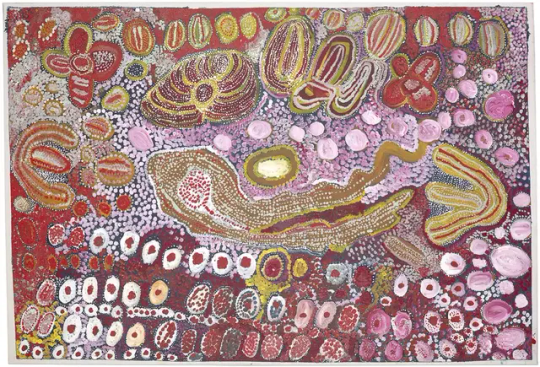
Wingu Tingima (Pitjantjatjara), Minyma Tjuta (Seven Sisters), 2006. © Wingu Tingima / Copyright Agency, Australia 2023. Courtesy of National Gallery of Victoria, Melbourne.
#Wingu Tingima#Pitjantjatjara#Minyma Tjuta#Seven Sisters#art by women#art#palianshow#women's art#art herstory#women painters
18 notes
·
View notes
Text
In the 1950’s the British government wrongly ascertained that Maralinga in South Australia was uninhabited. They carried out nuclear bomb tests, which are still impacting the community’s health. In the 1980s the government found significant radioactive residue in Maralinga and paid out $13.5million to the Pitjantjatjara people, too little too late.


look I know it’s supposed to be a joke but that “irradiated wasteland” is the unceded homeland of the Paiute and Shoshone peoples and consists of fragile Mojave and Great Basin desert ecosystems that are actively being exploited and destroyed by mining interests who utilize the perception of desert as wasteland to justify their destruction of indigenous lands and communities. the joke's not funny. fuck off with this.
#desert#Outback#Maralinga#Pitjantjatjara#indigenous people#civilization#nuclear bomb#Australia#First Nations#human rights#bombs#inhabited#south Australia#nuclear testing#Nevada#Mojave#wasteland#radiation#blak Australia#aboriginal
24K notes
·
View notes
Text
0 notes
Text
youtube
Thursday's Covers Day | Trevor Adamson - Nyanpi Matilda (Pitjantjatjara)
#jaunty cover of waltzing matilda in aboriginal language!!#thursday's covers day#trevor adamson#nyanpi matilda#pitjantjatjara#pjt#pamanyungan#australia#ausralia#1997#1990s#folk#Youtube
0 notes
Text

Winner of Hadley’s Art Prize 2023
Ngayuku Ngura (My Country)
by Vicki Yatjiki Cullinan
Acrylic paint on linen.
‘I am a Yankunytjatjara woman from Indulkana Community on the Anangu Pitjantjatjara Yankunytjatjara (APY) Lands in South Australia. My painting is connected to the Tjukurpa (ancestral stories) that I know, but also my paintings are an extension of who I am, and how I interpret my place in the world.’
Photograph: Hadley's Art Prize
Hadley’s Art Prize
#ngayuku ngura (my country)#artist#art#vicki yatjiki cullinan#acrylic paint on linen#indulkana community#culture#south australia#anangu pitjantjatjara yankunytjatjara (apy) lands#tjukurpa ancestral stories#hadley's art prize
2 notes
·
View notes
Text
Uluru Rock, Australia: Uluru also known as Ayers Rock and officially gazetted as Uluru / Ayers Rock is a large sandstone monolith. It outcrops near the centre of Australia in the southern part of the Northern Territory, 335 km south-west of Alice Springs. Uluru is sacred to the Pitjantjatjara, the Aboriginal people of the area, known as the Aṉangu. The area around the formation is home to an abundance of springs, waterholes, rock caves and ancient paintings. Wikipedia
963 notes
·
View notes
Text
Round 3 - Mammalia - Notoryctemorphia


(Sources - 1, 2)
The marsupial order Notoryctemorphia is commonly called the “marsupial moles.” It contains just one genus with two known species: the Southern Marsupial Mole (Notoryctes typhlops) (image 2) and the Northern Marsupial Mole (Notoryctes caurinus) (image 1).
Marsupial moles are rarely seen and poorly known, with N. caurinus being one of the most poorly understood mammals in all of Australia. They are convergent with the placental moles, living a fossorial lifestyle and only coming aboveground after rain. Notoryctids use two enlarged, spade shaped, flat claws on the third and fourth digits of each forelimb to dig in an up-and-down motion. They are functionally blind, their eyes reduced to vestigial lenses under the skin that lack a pupil. They have no external ears, just a pair of tiny holes hidden under thick hair. They have a leathery shield over their muzzle and their tail is a short, bald stub encased in leathery skin. They do not make permanent burrows or tunnels, but rather “swim” through the soil from place to place in search of food. They feed on earthworms and insect eggs and larvae, but have also been recorded to eat adult insects, seeds, and lizards if given the chance. They are between 12 and 16 centimetres (4.7–6.3 in) long, weigh 40 to 60 grams (1.4–2.1 oz), and are uniformly covered in fairly short, very fine pale cream to white hair with an iridescent golden sheen. Little is known about the preferred habitat of notoryctids, but they are more often found in sandy dunes or flats, and they are probably restricted to areas where the sand or soil is soft.
Notoryctids have a small but well-developed pouch that faces backwards so it does not fill with sand while the mother digs. It contains just two teats, so the animal cannot support more than two young at a time.
The order Notoryctemorphia has been around since the Oligocene. Notoryctids themselves are represented by early Miocene fossils of Naraboryctes and Yalkaparidon.
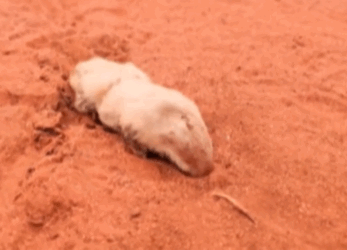
(source)
Propaganda under the cut:
Notoryctids are the only marsupials with a true cloaca.
Fossil evidence suggests that marsupial moles have been burrowing long before the Australian deserts came into being, staying underground while the terrain slowly evolved from jungle to desert.
Nineteenth century scientists believed that marsupials and eutherians had evolved from the same primitive ancestor and were looking for a living specimen that would serve as the missing link. Because the marsupial mole closely resembled the golden moles of Africa, some scientists concluded that the two were related and that they had found the proof. This, of course, was not the case, as scientists later discovered when better preserved marsupial mole specimens could be examined and were found to have a pouch. The coincidental similarities of the two species are, in fact, the result of convergent evolution.
The fact that the marsupial moles’ middle ear seems to be morphologically suited for capturing low frequency sounds, and that they produce high pitched vocalizations when handled, indicates that this kind of sound that propagates more easily underground may be used as a form of communication between marsupial moles.
Despite being generally unknown to European scientists, the Southern Marsupial Mole (Notoryctes typhlops) was known for thousands of years to Australia’s Indigenous people and was part of their mythology. It was associated with certain sites and dreaming trails such as Uluru and the Anangu-Pitjantjatjara Lands. They were regarded with sympathy, probably due to their harmless nature, and were only eaten during hard times. Aboriginal people generally cooperate with researchers by teaching them tracking skills and help with finding specimens. Their involvement has been instrumental in gathering information about the species’ habitat and behavior.
Marsupial moles have a presumably high impact on soil turnover, as they do not build burrows or tunnels, instead allowing the sand and soft soil to backfill behind them as they “swim”.
Large numbers of marsupial moles were collected in the early twentieth century, and informal reports of a fur trade using their pelts were reported.
As very little is known about marsupial moles, it is hard to access their conservation status, but records seem to indicate that they have declined. As 90% of medium-sized marsupials in arid Australia have become threatened due to domestic cat and red fox predation, it is likely marsupial moles are also threatened by these invasive predators. One study found remains of marsupial moles in 5% of the cat and fox faecal pellets they examined.
#I’m actually not sure if the first image is a Northern or just a mislabeled Southern but hey#animal polls#round 3#mammalia
55 notes
·
View notes
Text


HGUC 1/144 E.F.S.F. Mass-Produced Mobile Suit RMS-179 "GM-II" [Torrington Base Livery]
GM-II!! Saw this for $30 alongside the HGUC Nemo and had to add it to my growing GM collection. The GM-II was the Federation's contemporary to the Nemo, and was a direct improvement upon the original GM. Although it does wield the same beam rifle as the Nemo, (reusing the same sprue moulds that the Nemo uses) it had a less efficient fire control system and thus weaker output from the weapon. It also only holds a single beam saber, unlike the dual sabers of the Nemo.

This kit had excellent color separation. Like other GM-style kits, it only needs a little red detailing on the vents and boosters, plus some yellow for the head vulcans. I also used my chrome marker to paint the sensor behind the visor, which makes it stand out in a really distinct way, almost like a foil sticker. As usual, I also added some gunmetal and silver weathering to the grey parts, with some additional gold highlights. I also picked out all the sensors with a UV reactive green metallic, as the kit didn't include any foil stickers.
I wanted to use this kit for my local hobby group's photography competition, so I went the extra mile on detailing. The livery here is directly inspired by the Qantas Flying Art series, specifically the "Minyma Kutjara Tjukurpa/White Dots" livery by Pitjantjatjara artist Maringka Baker, and is meant to reflect the suit's (fictional) home base being in Australia. The design on the shield in particular reflects the fictional location of Torrington Base in relation to Sydney Crater, although this itself is rather inconsistent in UC media.

To make the build look professional I also used lots of decals and stickers. As mentioned in other posts, I'd already cannibalized the sticker sheet for my Asshimar and Nemo, but I saved most of the E.F.S.F. stickers for this kit. It includes some Torrington Base decals as well, as a nod to the GM-II's cameo in Unicorn. In addition I used spare decals from a variety of sheets including the Woundwort, GM Spartan, and a generic multi-use UC sheet. The "106" designation is purely based on what numbers I had left from stickers and decals. I locked everything in place with a second matte top coat.

The kit doesn't come with too many option parts. There's just an extra pistol grip hand as well as the two open fist options, and two beam saber effects in trans-yellow. I don't think it's necessarily a downside though, as it does limit how many leftovers there are to store after posing. It's a fairly flexible kit, with good hip and shoulder articulation, but it has no ab-crunch and limited waist rotation. You can still get it to hit some nice looking poses though.


For the photo competition, I took it out to The Beach, a horribly named location near Sydney Airport. It's a good spot for watching planes take off. I got some really nice pics, but I do wish I had something better than my phone camera to take advantage of the amazing weather and location.


Overall I had a lot of fun with this build, and I hope it does well in the competition! I'm super proud of how it turned out and I'm tempted to submit it for the Gunpla Builder's World Cup too.

The UC shelf just keeps getting more full...
#gunpla#my gunpla#hg gunpla#plamo#model building#gundam#mobile suit gundam#mobile suit zeta gundam#zeta gundam#gm#gm-II#gm ii#rms-179#efsf#sydney#australia
25 notes
·
View notes
Text
Places to travel to in your dr because why not the sequel
Part 1, Intro/Master post

1. Peperpot Nature Park, Suriname

2. Tupiza, Bolivia

3. Taktsang Monastery, Bhutan

4. Rainbow Mountains, China

5. Hinatuan Enchanted River Bluish, Philippines

6. Crooked Forest, Poland

7. Apostle Islands National Lakeshore, USA

8. Darvaza gas crater, Turkmenistan Proper safety is needed when visiting the Darvaza gas crater

9. Quinta da Regaleira Sintra, Portugal There is an inverted tower, it looks cool as fuck

Here's the other picture I guess

10. Valley of Flowers National Park, India

11. Wadi Rum, Jordan

12. Guyana Botanical Gardens, Guyana

13. Cappadocia, Turkey

14. Uluru, Australia Don't climb it it's disrespectful to the Yankunytjatjara and Pitjantjatjara people

15. Blackwater Falls State Park, USA

#shifting antis dni#reality shifting#shiftblr#shifters#shifting blog#shifting realities#reality shifter#shifting community#dr#shiftingrealities#shifting scenarios#shifting script
25 notes
·
View notes
Text
The Field of Lights at Uluṟu was designed as a 6 month exhibition in 2016 by Bruce Munro.
Years later it’s still going, but will end in 2027.
The exhibition, aptly named Tili Wiru Tjuta Nyakunytjaku or ‘looking at lots of beautiful lights’ in local Pitjantjatjara.


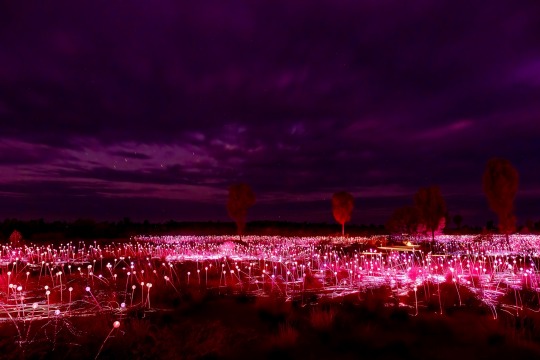
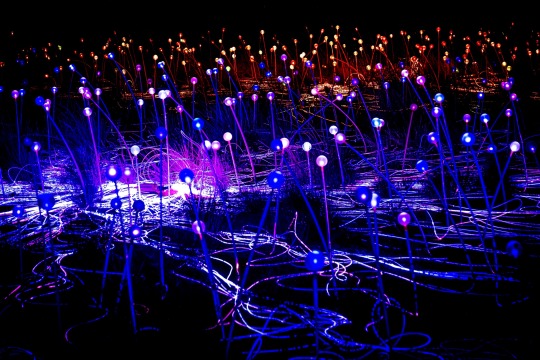
27 notes
·
View notes
Text
The Wild Westalia Fanzine is Out Now!

Howdy all! The Wild Westalia Fanzine is officially released into the wild! This zine aims to bring the western genre to Hetalia by showcasing western genre themed fanworks from various talented creators. All proceeds generated over one month go to Ngaanyatjarra Pitjantjatjara Yankunytjatjara (NPY) Women’s Council at a minimum of $3 USD - The zine will be completely free from 19 December onwards. 🤠 If any of this sounds like your kind of rodeo, make sure to donate and download through the Itch.io link down below!
ITCH.IO LINK: https://wild-westalia-fanzine.itch.io/wild-westalia-fanzine
@nsfhetalia @fuckyeah-hetalia @hetaliahappenings @heta-on-the-books
#wild westalia zine#hetalia event#hetalia#hetalia fandom#aph#hws#hetalia zine#hetalia world stars#hetalia events#historical hetalia#hetalia fanart#hetalia fanfiction
136 notes
·
View notes
Text
just turned in a 27 page paper 17 minutes before it was due. my eyes hurt, i'm so hungry, but at last i am free. god-willing, fic tomorrow.
(and if anyone out there wants to hmu about pitjantjatjara, ya girl just finished a semester's worth of work on it. hopefully i know my shit at this point.)
17 notes
·
View notes
Note
Do you have any dark skinned fcs you’d like to see gif packs of? I’m very faceblind and not as up on media as I should be but I’m practicing my work and would love to help those resources
Lori Tan Chinn (1948) Hoisan Chinese.
Nandita Das (1969) Indian.
Sendhil Ramamurthy (1974) Indian.
Grace Park (1974) Korean.
Nawazuddin Siddiqui (1974) Indian.
Dominique Jackson (1975) Afro Tobagonian - is trans.
Trevor Jamieson (1975) Pitjantjatjara / Kukatja, Noongar.
Florence Kasumba (1976) Ugandan.
Sterling K. Brown (1976) African-American.
Danai Gurira (1978) Shona Zimbabwean.
Konkona Sen Sharma (1979) Indian.
Nonso Anozie (1979) Nigerian.
Tannishtha Chatterjee (1980) Indian.
Yetide Badaki (1981) Nigerian - is bisexual.
Lupita Nyong'o (1983) Mexican Luo Kenyan.
Gabourey Sidibe (1983) Senegalese / African-American.
John David Washington (1984) African-American.
T'Nia Miller (1985) Afro Jamaican - is a lesbian - has spoken up for Palestine!
Radhika Apte (1985) Indian - has spoken up for Palestine!
Jodie Turner-Smith (1986) Afro Jamaican.
Chai Fonacier (1986) Bisaya Filipino - has spoken up for Palestine!
Susan Wokoma (1987) Nigerian - has spoken up for Palestine also has donated to an auction for Cinema4Gaza!
Lashana Lynch (1987) Afro Jamaican.
Michaela Coel (1987) Ghanaian - is aromantic - has spoken up for Palestine!
Ritesh Rajan (1988) Indian.
Anna Diop (1988) Senegalese.
Daniel Kaluuya (1989) Ugandan.
Andrea Bang (1989) Korean.
Lolly Adefope (1990) Yoruba Nigerian - has spoken up for Palestine!
Stephanie Hsu (1990) Taiwanese.
Varun Saranga (1990) Indian.
Shaunette Renée Wilson (1990) Afro Guyanese.
Antoinette Robertson (1990) Afro Jamaican.
Paapa Essiedu (1990) Ghanaian - has spoken up for Palestine and donated an auction to Cinema4Gaza!
Nyma Tang (1991) Sudanese.
Denée Benton (1991) African-American - has spoken up for Palestine!
Shamier Anderson (1991) Afro Jamaican.
Sheila Atim (1991) Ugandan.
Melinda Shankar (1992) Indo-Guyanese.
Clarence Ryan (1992) Unspecified Aboriginal Australian.
Haiesha Mistry (1993) Gujarati.
Kim Adis (1993) Bisaya Filipino.
Stephan James (1993) Afro Jamaican.
Nicole Kang (1993) Korean.
Baykali Ganambarr (1994) Yolngu.
Kofi Siriboe (1994) Ghanaian.
Simone Ashley (1995) Tamil Indian.
Mouna Traoré (1995) Afro Haitian and Malian.
Duckie Thot (1995) South Sudanese.
Brandon Soo Hoo (1995) Chinese - has spoken up for Palestine!
Ashton Sanders (1995) African-American.
Zuri Reed (1996) African-American.
Micheal Ward (1997) Afro Jamaican - has spoken up for Palestine!
Magnolia Maymuru (1997) Yolngu.
Jasmeet Baduwalia (1998) Indian.
Lovie Simone (1998) Ghanaian / African-American.
Olly Sholotan (1998) Nigerian
Hope Ikpoku Jnr (2001) Black British - has spoken up for Palestine!
Gerrard Lobo (?) Indian.
Jacob Junior Nayinggul (?) Yolngu.
Natassia Gorey-Furber (?) Central Arrente.
Jimi Bani (?) Wadagadum Torres Strait Islander.
Sasha Morfaw (?) Cameroonian.
Karim Diane (?) Mandingo.
Hey anon! I wouldn't consider these all to be dark-skinned but they're definitely considered dark in their respected industries. Please send in any suggestions and I can add them!
15 notes
·
View notes
Text










Kunmanara (Ruby Tjungawa) Williamson
Born: c 1940 near Wingellina WA
Died: 2012
Pitjantjatjara language group
Art Centre: Tjala Arts, Amata
‘I have shared my culture in my paintings for a long time, but culture is in everything I do - when I'm sitting down thinking, when I'm singing, when I'm making fire and cooking food, when I'm talking my language - It's just Anangu way and children know that way from when they're born’. Mrs Williamson, 2011.
Kunmanara (Ruby Tjungawa) Williamson was a Pitjantjatjara senior law woman committed to fostering traditional law and culture, story-telling, hunting, punu (wood) carving, dancing and painting. She was born in the bush around 1940 and came to live in Amata with her family when she was a young girl.
Mrs Williamson painted with Tjala Arts (formerly Minymaku Arts) since 2000 and was one of Tjala's most revered and charismatic artists. She received ongoing attention and acclaim for her unique and contemporary style. Ruby passed away in 2014.
note: Kunmanara is a term of respect used to replace the first name of Anangu who have died.
Mrs Williamson depicted the Musgrave Ranges, behind Amata. The large dark areas are the mountains from the side and above. She has also depicted Ultukunpa or Honey Grevillea flower which is a favourite bush food of the Anangu people. Ultukunpa grows in the sandy soils on the plains. The circles are kapi tjukula or rock holes where water collects after the rains.
https://www.ourstarshazelhurst.com.au/ruby-tjangawa...
23 notes
·
View notes
Note
Does Manifold have a confirmed ethnicity/nation?
Manifold is an Anangu man of the Pitjantjatjara from Mutitjula, Northern Territory.
2 notes
·
View notes
Text
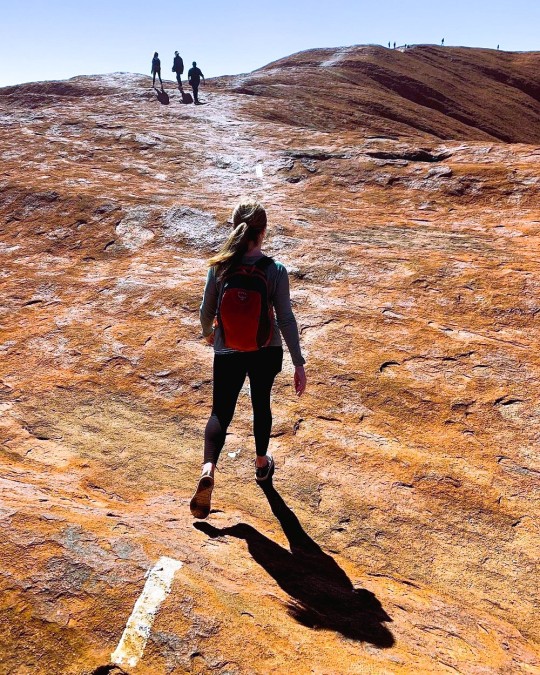
Uluru Rock, Australia: Uluru also known as Ayers Rock and officially gazetted as Uluru / Ayers Rock is a large sandstone monolith. It outcrops near the centre of Australia in the southern part of the Northern Territory, 335 km south-west of Alice Springs. Uluru is sacred to the Pitjantjatjara, the Aboriginal people of the area, known as the Aṉangu. The area around the formation is home to an abundance of springs, waterholes, rock caves and ancient paintings. Wikipedia
121 notes
·
View notes